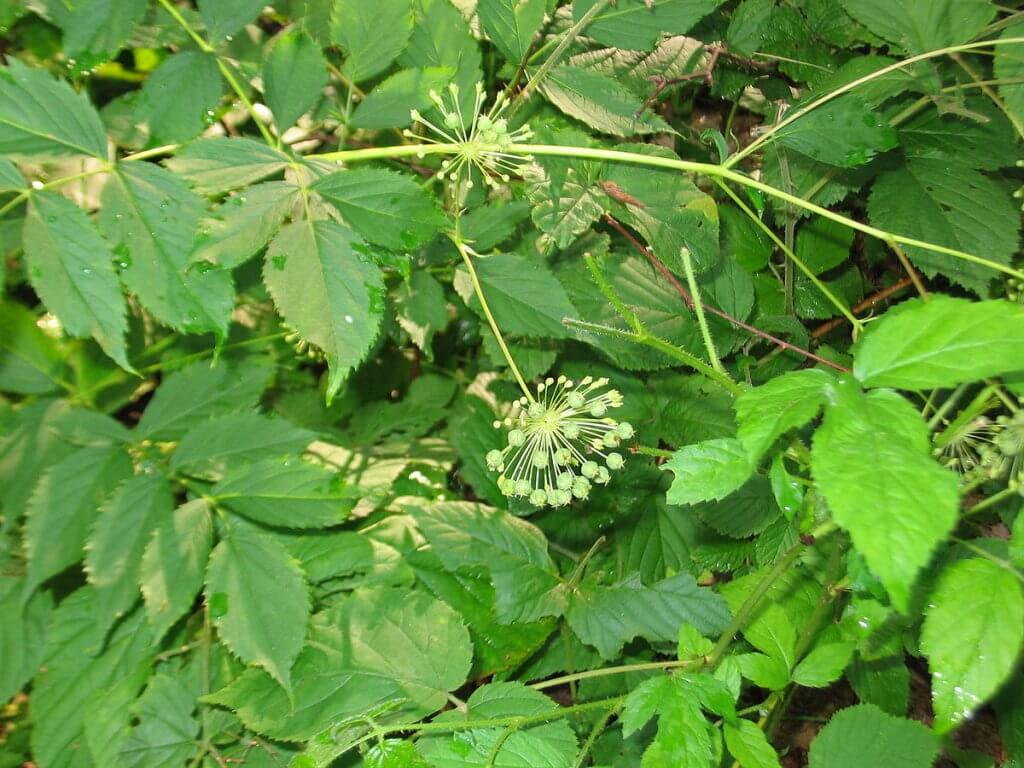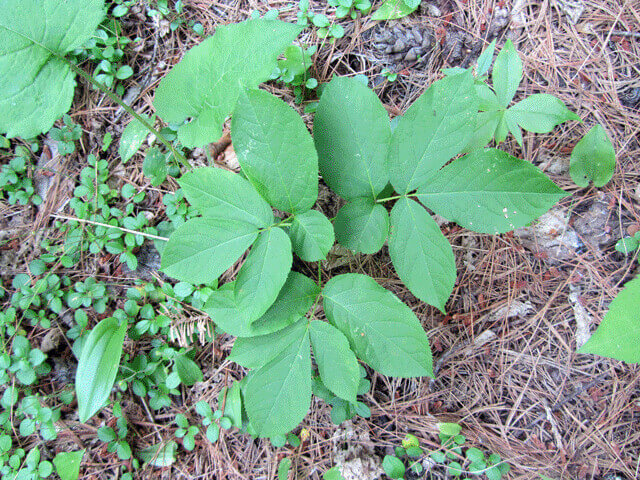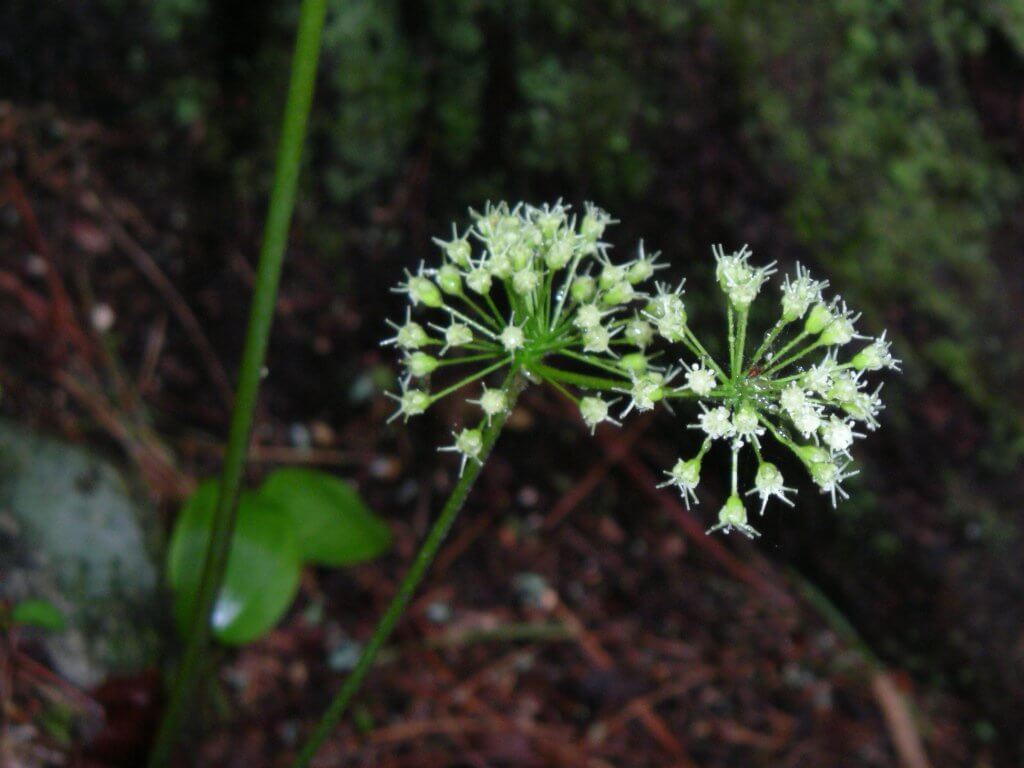A message from EatThePlanet.org: "We are happy you found us! We strive to be informative and accurate. Enjoy what you find here! Take a look at our new downloadable pdf eBook A Complete Guide To Foraging. We put a lot of work into this eBook and are very excited to share it with you." - Joe Forager(Owner)

(Photo by: Jomegat/Wikimedia Commons)
Despite their similar name, wild sarsaparilla (Aralia nudicaulis) is not related to the true sarsaparilla at all. Unlike true sarsaparilla which belongs to the Greenbrier family, wild sarsaparilla belongs to the Ginseng family. Wild sarsaparilla is a perennial flowering plant that comes from northern and eastern North America. This plant can easily be found growing on creeping underground stems in the woods.
This plant has had a long history with Native Americans. It’s considered a very filling food source as well as a wonderful herbal remedy. Also, much like its name suggests, the roots of this plant is often used as a substitute for true sarsaparilla roots in making root beer.
Edibility and culinary use
Wild sarsaparilla has a sweet spicy taste and a nice aromatic fragrant. The leaves, fruits, and roots of this plant are edible, but the roots are by far the most commonly used one. They’re used as a substitute for sarsaparilla, to make root beer, to make syrup, as well as to flavor other foods and beverages. Native Americans also used to eat wild sarsaparilla roots as emergency food, especially during wartime. This is because these roots are a wonderful source of energy.
Other than that, you can brew wild sarsaparilla leaves along with the roots to make a refreshing herbal tea. Young shoots are often cooked as a potherb as well. They can be stir-fried, blanched, or added into soups and stews. Lastly, ripe wild sarsaparilla fruits can be used to make wine and jelly.
Health benefits

(Photo by: Homer Edward Price/Flickr)
Much like its similarly named friend, sarsaparilla, wild sarsaparilla is an amazing medicinal herb. In fact, Native Americans have been using the roots of both plants interchangeably for making traditional herbal remedies. The roots can be made into a tincture, tonic, and herbal tea for internal use or used as a poultice for external use.
This herb has diaphoretic, diuretic, pectoral and stimulant properties. Aside from that, it’s also a great detoxifier as it encourages the body to sweat all the toxins out. Wild sarsaparilla can treat a lot of ailments. Internally, it’s used to treat cough, asthma, pulmonary diseases, rheumatism, and digestive problems. It can also help alleviate toothache and stomachache. Then, a poultice made from this herb can be used externally to treat sore muscles, joint pain, ulcers, burns, minor cuts, rash, insect bites, and other skin diseases such as eczema.
Cultivation
Wild sarsaparilla can easily be found growing in woodlands, especially if you live in northern and eastern US. But if you don’t want to go into the woods each time you want to use this herb, you can grow it in your own garden. This perennial herb isn’t hard to grow and it requires very little maintenance, especially if it has matured. Plant wild sarsaparilla on rich, loamy soil in a shady and protected area.
Wild sarsaparilla can be propagated from root cuttings. You can do this by digging up the roots when the plant is dormant in late fall. Cut the roots into 4” segments and lay them in a planting bed. Bury the root segments under 2” of soil and a layer of bark mulch. They can be transferred to their permanent position outside in their second spring.

(Photo by: Halpaugh/Wikimedia Commons)
Alternatively, you can also grow this plant from seeds. You can gather the seeds from ripe, unblemished fruits at the end of summer. If you can’t find any plants in the wild, simply buy the seeds online or from a nursery. It’s best to sow these seeds in the fall. They will germinate within 1 to 3 months. Once the seedlings are large enough to handle, place them in individual pots and let them grow in a greenhouse. Transfer them outside in late spring or early summer, be sure to give approximately 10” space for each plant.
Cautions
Wild sarsaparilla has no known hazard, but it’s always wise to consult your doctor or other medical providers before starting to consume this herb.
Be careful when foraging this herb in the wild. Wild sarsaparilla and poison ivy can look similar, especially in the spring when young plants just start to emerge. Young wild sarsaparilla plants will have three sets of 3 young leaves on its branches, just like poison ivy. A way to tell the difference between both plants is to check for the base of the plants and their leaf shapes. Wild sarsaparilla doesn’t have a woody base while its leaves have finely serrated edges.
It’s easier to tell them apart when the plants have matured. Mature wild sarsaparilla will have three sets of 5 leaves branching out from a common point on the stem along with little white or green flower clusters hanging below the leaves.
Conclusion
Wild sarsaparilla is truly a wonderful medicinal herb. It has had an extensive history as a herbal remedy. In fact, Native Americans tribes see this plant as a panacea and a valuable food source. With its uniquely distinct taste and potent medicinal properties, wild sarsaparilla will be a great addition to your daily diet. So, try taking a walk in the woods and see if you can find any wild sarsaparilla. Once you find it, why not try to cultivate it in your own garden? Its lovely green foliage will look amazing in any garden.
---------------
Writen by Cornelia Tjandra
Cornelia is a freelance writer with a passion for bringing words to life and sharing useful information with the world. Her educational background in natural science and social issues has given her a broad base to approach various topics with ease. Learn more about her writing services on Upwork.com or contact her directly by email at cornelia.tjandra@gmail.com
Many of our readers find that subscribing to Eat The Planet is the best way to make sure they don't miss any of our valuable information about wild edibles.
See our privacy policy for more information about ads on this site







4 Responses
Do you happen to have a recipe for making wine from the mature, ripened berries?
I do not have experience with making wine from this plant. Here is an article I found that looks pretty good for making sarsparilla wine. It goes over the different species. Keep in mind this article is written about species in the aralia genus and not the smilax genus.
http://winemaking.jackkeller.net/request101.asp
Hello Bill.
My mothers crude recipe was, 1 gallon sarsaparilla berries, 1 gallon sugar, 3 gallons water and 1 yeast cake. That was 60 years ago. I found a whole bunch last year and picked about 3 gallons. I wasnt prepared and they spoiled but the overwhelming fragrance brought back memories. It makes the absolute best wine on the planet. My mother knew little about winemaking but this recipe worked very well. Gervais
Unfortunately, the Wild Sarsaparillas have totally invaded my lawn area – is there any way of riding them? Thank you